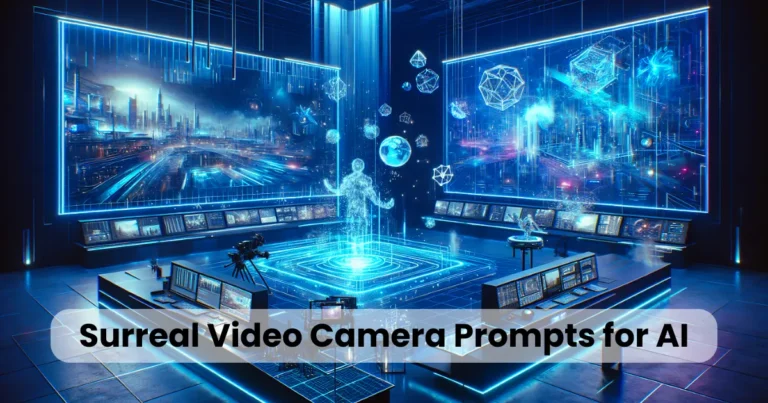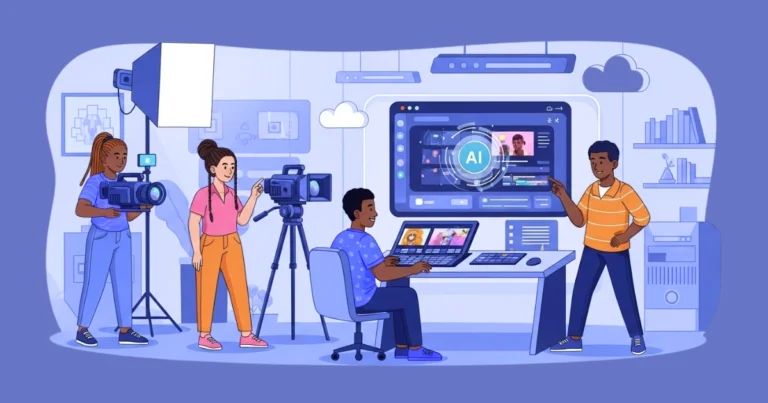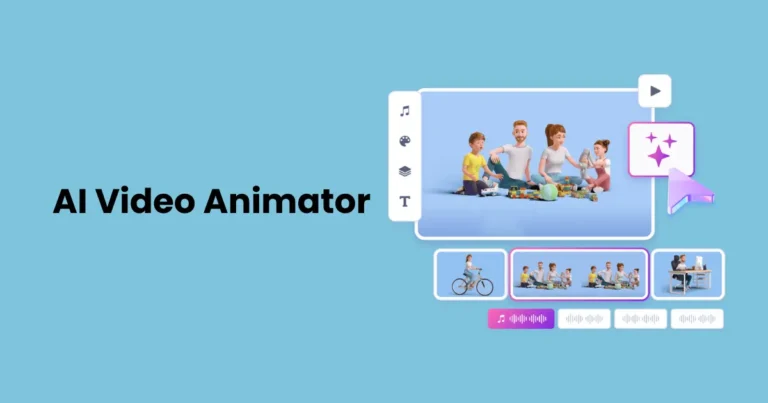AI Video for Creating Music Videos Guide

Contents
In the ever-evolving world of digital content creation, the AI video for creating music videos guide has become an essential resource for musicians, content creators, and visual storytellers. Thanks to recent advancements in artificial intelligence, music videos can now be produced more efficiently than ever before. Not only can high-quality visuals be generated automatically, but the editing process is also streamlined, saving both time and money.
Moreover, with the increasing availability of AI-powered platforms, creators of all skill levels can now bring their musical visions to life without needing advanced technical expertise. From beat-synced animations to surreal, stylized backdrops, the possibilities offered by AI are both vast and inspiring. In this guide, you’ll discover how to harness the power of AI to produce compelling music videos that stand out in a competitive digital landscape.
Why Use AI Video for Creating Music Videos
Creating music videos has traditionally been a resource-intensive task, requiring a combination of filming equipment, editing software, and skilled professionals. However, with the rise of AI tools, this process has been transformed dramatically. AI video for creating music videos guide offers a powerful alternative, enabling artists and creators to produce visually captivating content with far fewer resources.

First and foremost, AI eliminates many of the technical barriers. Video production used to demand a steep learning curve, but now intuitive AI platforms can handle complex tasks such as motion tracking, visual effects, and scene transitions. As a result, creators can focus more on the artistic direction rather than the technical execution.
Additionally, AI tools provide speed and efficiency that traditional methods simply can’t match. Videos that once took days or even weeks to edit can now be generated in a matter of hours. Because the footage is processed automatically, time-consuming manual edits are often unnecessary.
Moreover, AI enables customization on a level that was previously out of reach for many creators. Visuals can be styled to match the mood of a track, and scenes can be generated based on lyrics, genre, or even emotion. This level of flexibility opens new doors for storytelling and artistic expression.
Finally, cost-effectiveness is a major advantage. For independent artists or content creators with limited budgets, professional-looking music videos can now be produced without hiring expensive video editors or renting equipment.
In short, AI video for creating music videos guide highlights how artificial intelligence not only simplifies the production process but also empowers creators to deliver innovative, high-quality visuals faster and more affordably.
Best AI Tools for Music Video Creation
Choosing the right tools is crucial when following any AI video for creating music videos guide. Fortunately, several platforms have been designed to cater specifically to the needs of modern music video creators. These tools combine automation with creativity, offering features like beat detection, text-to-video generation, and visual effects that adapt to audio.

1. Kaiber
Kaiber is known for turning still images or concepts into dynamic AI-generated music videos. It is particularly popular for creating animated sequences that sync beautifully with musical rhythm. Moreover, its storytelling features allow users to guide the visual narrative based on lyrics or themes.
2. Runway ML
Runway ML offers powerful machine learning models for video creation and editing. It supports motion tracking, background removal, and stylized effects, making it a go-to tool for those who want more control over the final product while still benefiting from AI automation.
3. Pika Labs
If you’re looking for beat-synced visual flair, Pika Labs excels in generating real-time, music-reactive visuals. It’s ideal for artists who prefer abstract or animated aesthetics that pulse and evolve with the rhythm of the track.
4. Synthesia
Although primarily used for corporate or educational content, Synthesia is also effective for lyric videos. With its AI-generated avatars and text-to-speech options, it’s a unique choice for creators looking to incorporate digital performers into their music videos.
5. WavTool
WavTool is perfect for those who want to combine audio mixing with visual creation. It offers AI-powered editing tools that adapt visuals based on the music track’s tone, tempo, and structure—creating a harmonized experience between sound and imagery.
6. DeepMotion
For animated character-driven music videos, DeepMotion uses motion capture and AI to bring avatars to life. Movements are synced with the music, allowing performers to be digitally represented with stunning realism.
Each of these platforms offers a different angle on the process described in this AI video for creating music videos guide, allowing creators to find the perfect match for their project’s tone, budget, and creative vision.
Step-by-Step Guide to Making a Music Video with AI
Creating a music video may seem daunting at first, but with the right approach and the support of this AI video for creating music videos guide, the process becomes surprisingly straightforward. Below is a detailed breakdown to help you move from concept to completion using AI tools.

1: Define Your Vision
To begin with, outline the theme, mood, and overall aesthetic of your music video. Consider the story you want to tell or the feeling you aim to evoke. Whether it’s a dreamy visual experience or a high-energy animation, knowing your vision in advance will help guide every subsequent step.
2: Choose the Right AI Tool
Next, select a platform that aligns with your creative goals. For instance, Kaiber is great for dreamy animations, while Runway ML offers more manual control. Take into account the tool’s capabilities, user interface, and whether it supports features like beat sync or lyric-driven visuals.
3: Prepare Your Audio Track
Ensure that your audio file is ready and of high quality. Most AI platforms support MP3 and WAV formats. Since the video will often be synced to your audio, clean and finalized music is essential for optimal results.
4: Input Visuals or Generate with AI
At this point, you can either upload your own visuals—such as images, video clips, or artwork—or let the AI generate content based on prompts. Many tools offer the ability to create video segments entirely from scratch using text descriptions or mood keywords.
5: Edit and Enhance the Output
After your first draft is generated, refine it using the built-in editing features. You might want to adjust transitions, apply visual effects, or fine-tune the alignment between audio and video. Enhancements like filters, overlays, and pacing adjustments can dramatically improve your final product.
Finally, export the music video in your desired format and resolution. Many platforms allow for direct uploads to YouTube, Instagram, or TikTok, making the distribution process quick and easy. Before publishing, preview the full video to ensure everything appears as intended.
Tips for Enhancing Your AI Music Video
Once your video has been generated, the next step is to elevate its quality. Even when much of the work has been handled by AI, a few thoughtful enhancements can make the final product truly memorable. This section of the AI video for creating music videos guide outlines proven techniques to help your video stand out.

1. Add Custom Transitions
Although most AI tools provide automatic transitions, manually adding your own can create a smoother visual flow. Consider fading in during emotional moments or cutting sharply during energetic beats. This technique enhances rhythm and visual engagement.
2. Match Visuals to Lyrics
Whenever possible, synchronize key lyrics with visual changes. For example, if a line mentions “the sky,” showing an AI-generated sky background adds cohesion. This lyrical alignment adds meaning and keeps the viewer emotionally connected.
3. Use Text and Captions Creatively
In addition to visuals, creative text overlays or animated lyrics can make your video more dynamic. This is especially useful for platforms like TikTok or YouTube Shorts, where viewers appreciate quick, engaging visuals.
4. Integrate Motion Effects
To create a sense of energy and flow, add subtle motion effects. Even a slight zoom or camera pan applied to static AI-generated images can make a big difference. These enhancements help keep the video feeling alive and in sync with the audio.
5. Play with Color Grading
Adjusting the color tones can drastically change the mood of your music video. Warm tones may suit love songs, while darker shades work well with more intense tracks. Many AI platforms offer built-in filters or color adjustment tools to assist with this.
6. Test on Different Devices
Before finalizing your upload, preview the video on various devices. What looks great on a desktop may appear too dark or cluttered on a mobile screen. Since most audiences watch music videos on mobile, optimizing for those screens is a smart move.
7. Blend AI with Real Footage
If possible, combine AI visuals with real-world footage. For instance, you could shoot a short intro and then let the AI take over. This hybrid approach adds authenticity and depth to your project.
By applying these strategies, the results from any AI video for creating music videos guide can go from impressive to unforgettable. Your final video will not only reflect your creative intent but also capture and hold the attention of your audience.
Common Mistakes to Avoid
Even though AI tools simplify the video creation process, several common pitfalls can still compromise your final product. This portion of the AI video for creating music videos guide highlights what to avoid so your music video remains polished and professional from start to finish.
1. Ignoring Sync Between Audio and Visuals
One of the most frequent mistakes involves poor synchronization. If the beat drops but the visuals lag behind, the entire video can feel disjointed. Therefore, always review timing during edits and make manual adjustments if necessary.
2. Overloading with Effects
Although AI platforms offer a variety of effects, using too many can overwhelm the viewer. Flashy transitions, intense color changes, and rapid scene shifts may distract rather than enhance. Instead, keep your visuals clean and consistent to support your song’s message.
3. Relying Completely on AI Without Input
It might be tempting to let the AI handle everything. However, skipping customization leads to generic-looking results. To truly benefit from the AI video for creating music videos guide, you must give the tool direction—such as style prompts, mood references, or lyrical cues.
4. Skipping the Planning Phase
Jumping directly into production without a storyboard or concept is a recipe for chaos. Even a rough visual outline helps maintain consistency and narrative flow. Think of AI as a creative assistant—it performs best when given a clear task.
5. Forgetting Copyright and Licensing Rules
AI-generated content isn’t always free from legal concerns. If you’re using music, images, or footage that isn’t original or royalty-free, you may face copyright issues. Always double-check usage rights before finalizing your project.
6. Not Testing Output Quality
Sometimes creators export videos without verifying resolution, aspect ratio, or frame rate. Low-quality video can reduce viewer engagement, especially on high-resolution platforms like YouTube. Make sure your final output matches the platform’s standards.
7. Failing to Optimize for SEO and Sharing
Lastly, even a great music video won’t get noticed if it’s not optimized. Forgetting titles, tags, and thumbnails can limit reach. Therefore, treat the uploading and sharing stage with the same care you gave production.
By steering clear of these common errors, you’ll ensure that your experience with this AI video for creating music videos guide results in a product that’s visually compelling, technically sound, and audience-ready.
Future Trends in AI Video Music Production
As technology continues to evolve at a rapid pace, the future of AI-generated music videos looks more innovative than ever. Based on current developments, several exciting trends are beginning to shape what lies ahead in this field. Following this AI video for creating music videos guide will not only help you succeed today but also prepare you for what’s coming next.

1. Real-Time Music Video Generation
Soon, music videos could be generated in real time during live performances or streams. As AI becomes more powerful, it will be able to create responsive visuals that shift based on audio input instantly—offering an immersive, dynamic experience for fans.
2. Hyper-Personalized Visuals
AI systems are beginning to adapt content based on user data. In the near future, viewers might receive tailored music videos where visuals match their preferences, mood, or listening history. This personalized experience could dramatically increase engagement.
3. Deep Integration with AR and VR
Artificial intelligence will likely merge with augmented and virtual reality platforms to create fully interactive music video environments. Viewers might explore 360° visual worlds, interact with elements, or even influence video direction—blurring the line between passive watching and active participation.
4. AI-Created Performers and Avatars
Virtual artists powered by AI are already gaining attention. In music video production, digital avatars that dance, perform, and emote in sync with songs will become more common. This trend opens up creative freedom for producers to feature non-human performers who never age, tire, or miss a beat.
5. Text-to-Video Becoming the Norm
As natural language processing improves, artists will soon describe a scene or vibe in plain text—and AI will bring it to life visually within seconds. This advancement will further streamline the process outlined in any AI video for creating music videos guide, removing the technical barriers even more.
6. Ethical AI and Content Authenticity
With increasing use of AI in creative spaces, discussions around originality, ethical creation, and deepfake prevention are gaining traction. Future platforms may include built-in tools to verify authenticity and provide transparency in AI usage—protecting both creators and audiences.
Clearly, the world of AI music video production is only just beginning. As these trends unfold, creators who adapt early will have a competitive edge—especially those already guided by a forward-thinking AI video for creating music videos guide.
Conclusion
To wrap things up, it’s evident that artificial intelligence has revolutionized the way music videos are created. What once required expensive equipment, large teams, and extensive technical knowledge can now be done with powerful AI tools and creative vision. This AI video for creating music videos guide has provided you with everything you need—from choosing the right tools to avoiding common mistakes.
By combining automation with artistic direction, creators at any level can now produce videos that rival professional productions. Furthermore, as trends continue to evolve, staying informed and adaptable will keep your content fresh and competitive.
So, whether you’re just starting or looking to enhance your workflow, let this guide be your go-to resource. Embrace the future of music video production—and let AI help bring your creative ideas to life.






